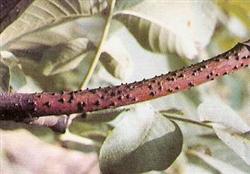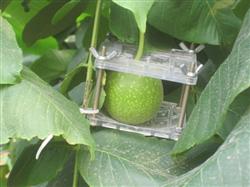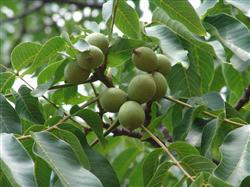What is walnut branch blight?

What is walnut branch blight? How to prevent and cure it? Please advise that walnut branch blight is caused by fungal infection, which mainly harms the branches. It occurs everywhere, the general disease plant rate is 20-30%, and the serious disease plant rate is more than 80%, causing a large number of branches to die, directly affecting the tree growth and the yield and quality of walnut. Therefore, it is necessary to timely prevent and control the disease, promote tree development, improve yield and quality, and increase efficiency. 1. Disease identification: the leaves on the injured branches gradually turn yellow and fall off: the cortex of the diseased branches gradually turns green, becomes grayish brown at the initial stage, and then becomes light reddish brown to dark gray, and the cortex dries and cracks and reveals grayish brown xylem. When the disease spot expands around the branch for a week, the branch dies, or even the whole plant dies. Second, the cause of the disease: 1. The garden cleaning is not complete. The pathogen overwintered on the withered branches and spread by wind, insects and Rain Water in the following spring. The disease began from May to June, and the peak period was from July to August. 2. Management is not in place. First, the lack of water and fertilizer weakens the tree, reduces disease resistance, and increases the incidence; second, soil consolidation, poor root development, and reduced absorption function; third, mechanical wounds caused by careless operation in the process of management, which is conducive to the invasion of bacteria; fourth, late frost injury is easy to cause young trees and twigs to infect the disease. 3. It is easy to cause disease due to shade in the garden, poor ventilation and light transmission, tender and weak branch growth. Third, prevention and control measures 1. Clear the garden thoroughly. In winter, remove dead branches, fallen leaves and diseased fruits from the garden and take them out of the garden and burn them. The tree trunk was whitened with 12.5 kg of quickash, 0.5 kg of sulfur powder, 1.5 kg of salt, 0.25 kg of vegetable oil and 50 kg of water. 2. Strengthen the management. First, turn the soil deeply, when the walnut is harvested and before the defoliation, the soil is deeply ploughed to mature the soil, promote the root system development and improve the absorption function. The suitable depth is 20-30 cm. The second is to apply sufficient fertilizer, combined with 150-200 kg of rotten organic fertilizer per adult tree, and once nitrogen, phosphorus and potassium compound fertilizer from June to July. The third is timely irrigation to promote the healthy growth of trees and improve the ability of disease resistance. 3. Cut off the dead branches. Cut off the diseased branches in time and take them out of the garden to burn. At the same time, do a good job in summer cutting, remove dense branches, disease and insect branches, grow branches, improve ventilation and light transmission conditions, and reduce the incidence of disease. 4. Chemical control. The obvious control effect can be obtained by spraying 70% methyl topiramate wettable powder 800-1000 times or mancozeb wettable powder every 10 days for 3-4 times from June to August. At the same time, it is necessary to control stem pests such as longicorn beetles and walnut bugs in time to prevent bacteria from invading by wormholes. Click to get more walnut planting techniques click to get more fruit planting techniques
- Prev

How to spray walnut foliar fertilizer
How to manage hemp walnut in July and August? Please give guidance on the management methods of hemp walnut in July and August, please refer to the following: first, water and fertilizer management water. The fruit size of the tree that has hung fruit has been basically fixed by July and entered the stage of shell hardening. There is no need for artificial watering during this period. If there is too much moisture in the soil, it will cause fruit shell whitening and fruit tip hair.
- Next

How can walnuts be thinned?
How can walnuts be thinned? Please introduce that scientific fruit thinning of walnut is not only beneficial to the development of walnut in the same year, save a lot of nutrients and water, improve the yield and quality of nuts in the same year, but also benefit the growth of new shoots and ensure the yield of the following year. It is the main technical measure to improve the yield and quality of walnut.
Related
- Moge, come on! The staff of the peasant association in the producing area of cantaloupe were frightened when the crowd gathered.
- Causes and Solutions of low Fruit setting rate of Apple
- Symptoms and control measures of passion fruit virus disease
- Fruit growing lesson: how do apple orchards keep high yields?
- Can you build orchards in the mountains? What are the pros and cons?
- How to manage the coloring period of Crisson grape?
- This paper introduces the processing technology of two kinds of fig products.
- How much is a month for retired teachers in rural areas by 2020?
- How can strawberry planting increase sugar content? We should pay attention to management in many aspects.
- What are the cultivation techniques on how to improve the yield of golden fruit?

